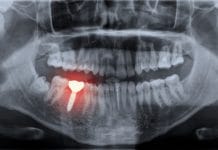Trust me; we have all been in this position before. As soon as we sit the patient down in the dental chair, we experience resentment and fear. As a dental hygienist, I cannot begin to tell you how many times patients tell me that they hate the dentist. I personally find it amusing the way the patient explains this like it is a new phenomenon. “Honestly, I hate being here. I hate the SCRAPING, and I hate NEEDLES!” At this particular moment, we can observe their hands shaking or fidgeting, or their body language is as stiff as a board.
As compassionate clinicians, we know its time to have the all too familiar battle of empathy, frustration, patient education, and of course patient comfort. How do we gain the patients trust? How do we keep ourselves safe from jumping out of our chair each time the patient reacts? Recently, I have had numerous patients show outstanding progress in conquering their phobias. Their oral health has improved, they are coming to their appointments more frequently, and most importantly, they feel safe in the dental chair. As a provider, I too can keep my heart rate down and provide top quality care!
It is heartbreaking and frustrating when we see a patient that has put off their dental visits for years and years due to a phobia. Recently, I had a beautiful young patient in her early twenties come in with her chief complaint being, “bad breath and teeth hurting.” Her exam indicated aggressive periodontitis and rampant decay. She explained that a scary experience with an orthodontist as a child left her with unfinished orthodontic treatment, shameful home care (or lack thereof), and overdue dental care.
After her first appointment with us, I knew this was going to be a challenge. She was in pain and needed extensive treatment to get her back on track. As I scheduled her for her scaling and root planing, she looked fearful and anxious, similar to a person awaiting their verdict on trial. I went through the familiar battle again of empathy, frustration, patient education, and patient comfort. During her first visit for periodontal therapy, she began to cry and shake even with the aid of nitrous oxide. It was at that moment I knew she had a serious phobia and I needed to help.
I now see her every three months for her maintenance appointments and her oral health has improved dramatically. She thanked me for changing her outlook, and she is now out of pain and can smile with confidence. I did this by targeting a few key things: communication, body language, control, and education.
When seeing a patient with dental phobia, the first step is communication. We communicate with each patient all day, every day, but when a patient looks visibly anxious, fearful, or skeptical, I don’t even put on their bib until I break down and explain their entire appointment. Removing the fear of the unknown can help the patient understand that there will be as little surprises as possible and that the appointment will be smooth sailing. “Mrs. Jones, first I’m going to use this mirror to look around, then I will take some measurements.” I make sure that I talk to the patient about what comes next in the appointment by using soft wording and eliminating upsetting words; words such as poke, bleeding, pain, hurt, or shots. If the patient expresses concern or has a question, I always like to support them by saying “That’s a great question,” or, “I’m glad you brought that up.” Adding support to their concerns or questions (no matter how outlandish) can easily boost their confidence during their appointment.
From what I have seen, communication plays the biggest role in gaining the patients trust. I want to relay the message that I am their friend, and I’m on their side. I like to use a phrase such as, “It sounds like you have had a negative experience in the past and I want to help you.” This generally comes across better than, “Did you have a bad dental experience?” Or the word, “painful.” If possible, a little humor can go a very long way in a dental atmosphere. I understand that not everyone is a comedian or in the mood to laugh, but a light-hearted joke can move mountains for a patient’s relaxation.
To break down communication, talk through the process of the visit; use soft wording and be on their side as a friend rather than talk down to them. No matter how much we secretly want to eye roll and tell them to “man up,” it’s important to remain open-minded to individual human experience and take the opportunity to change patients’ outlook on their oral health.
Second, is body language. Just like we can pick up on the fidgeting, sweating or shaking, patients can pick up on ours too. If we are multi-tasking, in a hurry, frustrated, or tired, their dental phobia will carry on throughout the appointment. Depending on the appointment, the practice, or the situation, it is important to hide any negativity from our patient. When I break down the appointment before the bib goes on, I sit at eye-level, mask off, arms uncrossed, and smile as much as I can when appropriate. A head nod of encouragement can make all the difference as well. I have noticed that body language can send a positive and comforting signal to the patient sitting in the chair.
The third way to treat dental phobic patients is to give them a sense of control without compromising your implementation of treatment. For example, after I finish communicating the breakdown of the appointment and have answered questions and concerns, I will ask, “Is it ok if we lay you back?” This gives the patient control immediately by answering yes or no. Depending if you are a right or left handed clinician, the key to a patients comfort is a safe signal. “Raise your left (or right) hand if you need a break or if you experience discomfort in any way. As soon as you raise your hand, I will immediately stop”. This is one of the most effective ways I have seen patients with dental phobias make it through their appointment.
By giving a patient the sense of control, we are removing the fear of the unknown by letting them lead. We are taking a vulnerable situation of being in the dental chair, and giving them the ability to set the pace of their procedure. Depending on the phobia, a patient may want to hold the suction or another may need to hold a hand mirror. Always ask them if they are comfortable with the next step. “I’m going to clean around the bottom molars a little more is that okay?” Giving the patient a sense of control can also help eliminate the all too familiar jumps and grunts that send us clinicians into tachycardia.
Lastly, after implementing communication, body language, and comfort, it is so important to educate the patient as to why we do what we do. Once the patient understands the mouth and body connection and the influence of prevention, we can address that dental visits will get easier and more comfortable. I always like to educate the patient in a calm and understanding tone because no one wants to be talked down to. Most dental phobic patients have a level of understanding that their mouths are in an unhealthy state. If we scold them or sound belittling when we try to educate them, they will most likely shut down, and their oral care neglect will continue out of shame rather than knowledge.
In conclusion, I have learned from being in the field over ten plus years that honoring the human experience and seizing the opportunity to change someone’s outlook on their oral health and dental experience is not easy. It may take a particular patient six years to see change or take another patient six months. Please don’t get discouraged if there are patients you can’t help. The extreme phobias will most likely result in general anesthesia for everyone’s safety. However, those whose outlook you can change, creates an accomplishment for the patient, the practice, and most of all yourself, as a healthcare professional.












